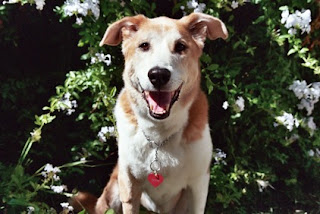Cannabis is now accepted as medical treatment for dozens of
ailments in humans. But what about cannabis
for dogs? Yes, there is such a thing and it’s used to treat anxiety, pain and even
cancer in canines through the use of CBD oil. The new book, Cannabis
and CBD Science for Dogs by D. Caroline Coile, Ph.D., a former canine consultant to
the FAA and award-wining dog writer, examines the ways cannabis helps sick and
aging canines.
The book explains first things first - the differences
between marijuana, cannabis and hemp; the history of cannabis for medicinal
purposes, and how different cannabinoids affect humans and animals.
CBD is one of the cannabinoids found in marijuana and hemp. The most well-known, THC,
is found in marijuana and has the psychoactive properties that make you high. CBD,
a cannabinoid used to treat health issues in humans and pets, is the opposite
of THC in several ways. Marijuana containing
THC makes people anxious and paranoid, but
the CBD found in hemp has a calming effect. The
THC in marijuana makes users sleepy, but CBD
is an energy-booster. Many types of CBD
oil and related products are cleared for legal sale in the United
States.
The chapter on clinical applications examines the uses of
medical cannabis for canines. The list of treatable maladies mirrors the ones
found in humans - anxiety, colitis, obesity, diabetes and cancer, to name just
a few. The book contains case studies of dogs receiving relief from severe pain
due to CBD treatment. There are a few
easy-to-read charts featuring the types of cannabinoids and what canine health
issues they treat, and other information to help you make an informed decision
about your dog’s health care.
This 94 page book covers the what, how and why of medical
cannabis for dogs. If you’re tired of repeat visits to the vet, medical
cannabis may be the answer to your pet’s health problems. The author examines
the ways CBD improves canine health and
clears up the confusion some people may have about the types of cannabis
(marijuana vs. hemp), and how they’re used.
Here’s a primer for the information contained in Cannabis and CBD Science for Dogs, via an email interview I
conducted with the book’s author. (She is also a columnist for Dog World magazine and the AKC Gazette.)
When was cannabis first used as a treatment
for ill or elderly dogs?
We don't specifically know when it was
first used for dogs, but the ancient Greeks used cannabis to dress wounds on
their horses, so it's not much of a stretch to assume they also used it on
their dogs. And of course, they also used it on themselves!
What is the difference between CBD and THC? Can my dog get
"stoned" from using CBD?
CBD and THC are related but
different types of cannabinoids, which are chemicals found in cannabis plants.
Cannabinoids affect the body's endocannabinoid system, which is a master
regulator of the body's internal systems. In the 1960s the cannabinoid THC was discovered and
got all the credit---and it is the one responsible for the "high" you
get from marijuana. But now another cannabinoid, called cannabidiol (CBD), is getting
credit for most of the medicinal benefits. CBD doesn't get your
dog high, and it comes from hemp, not marijuana.
What conditions are treated with cannabis?
A crazy assortment of conditions are
treated with cannabis, especially with CBD: Pain, age-related
cognitive losses, inflammation, seizures, arthritis, autoimmune disorders,
infections, even to some extent cancer. And while I agree that list sounds to
unrelaed to be credible at first, the thing that ties them together is the
systems that influence all these conditions are controlled by endocannbinoids.
Is the medical marijuana for pets different
than medical marijuana for people?
Medical marijuana, with THC, comes from plants
cultivated to have high THC content. It is
illegal to use on dogs, even where it's legal for people. Veterinarians cannot
prescribe it. CBD comes from hemp plants, which have
been cultivated to have low THC bit subsequently
have high CBD, Hemp, with CBD, is legal.
How do I know if the cannabis I give my pet
is safe?
As with any herb, know your source. I feel
more confident with companies that have a history of supplying CBD.
Canna-Pet, for example, has probably the longest history and best
documentation, and is my personal choice.
Is cannabis added to your dog’s food or
administered like medication?
It depends on your source, but ideally
it's administered so it's absorbed before it get sto the digestive tract.
Can vets prescribe it or do you get it
over-the counter?
You don't need a prescription for CBD as it is totally
legal to buy over the counter. Some veterinary clinics stock it, however, and
have it on hand for cases they think would benefit from it. But right now, not
all veterinarians understand CBD, or that it is
legal and different from medical marijuana.









